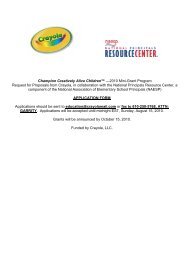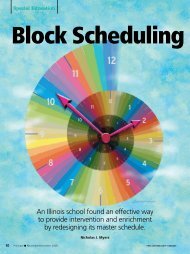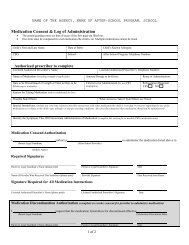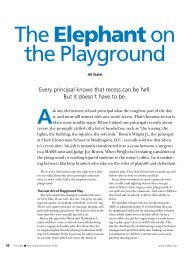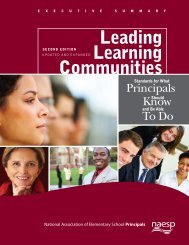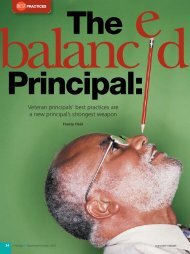The Seven Habits of Effective Principal Preparation Programs
The Seven Habits of Effective Principal Preparation Programs
The Seven Habits of Effective Principal Preparation Programs
Create successful ePaper yourself
Turn your PDF publications into a flip-book with our unique Google optimized e-Paper software.
TRAINING TOMORROW’S PRINCIPALSheSev18<strong>Principal</strong> ■ May/June 2005PHOTO: ALEX FREUND/IMAGEBANK
<strong>The</strong> authors’ research foundseven answers to the question“What constitutes successfulprincipal preparation programs?”James Davis and Michael Jazzarn <strong>Habits</strong><strong>of</strong> <strong>Effective</strong><strong>Principal</strong><strong>Preparation</strong><strong>Programs</strong>Even as our nation’s schools continue to faceincreasing challenges, ranging from student violenceand deteriorating facilities to acute teachershortages and substandard student achievementrates, principals are expected to enter their schools moreprepared than ever to provide excellent leadership.IN BRIEF<strong>The</strong> authors examined 14 principalpreparation programs and foundseven consistent instructional andlearning actions, or habits, they believeestablish a framework for providingfuture educational leaders withopportunities to connect their knowledgeto reality through carefullydesigned experiences.<strong>The</strong> most critical step in any systematiceffort to cultivate effective schoolleadership may be to align principals’performance to recognized standards(Young and Peterson 2002). Unfortunately,until recently there had beenno nationally accepted standards bywhich to evaluate that performance.Not until 1996 was the Council <strong>of</strong>Chief State School Officers’ InterstateSchool Leaders Licensure Council(ISLLC), with assistance from 24 stateagencies and a number <strong>of</strong> pr<strong>of</strong>essionalassociations, able to develop six standardsto guide principal performance(Green 2001). <strong>The</strong> ISLLC standardswere subsequently embraced by thewww.naesp.org <strong>Principal</strong> ■ May/June 2005 19
National Council for Accreditation <strong>of</strong>Teacher Education and the NationalPolicy Board as the basis for their ownStandards for Advanced <strong>Programs</strong> inEducational Leadership, which areused to accredit educational leadershipprograms in many colleges and universitiesacross the nation.Too <strong>of</strong>ten, however, principal preparationprograms continue to lack thecurricular coherence, rigor, pedagogy,and structure to provide the kinds <strong>of</strong>knowledge, skills, and dispositionsneeded to produce well-qualifiedschool leaders (Jackson and Kelley2002). <strong>The</strong> quest to improve educationalprincipal preparation programscontinues.<strong>The</strong> authors, who collectively have40 years <strong>of</strong> K–12 school and districtleadership experience, share thisquest. With the question “What constitutessuccessful principal preparationprograms?” firmly planted in ourminds, we examined 14 leadingeducational leadership programs andconducted extensive interviews.Cultivating Good <strong>Habits</strong>As each program was investigated,data analyzed, and comparisons established,we found seven instructionaland learning actions repeated timeand again. We labeled them as theseven habits <strong>of</strong> effective principalpreparation programs, and they havebeen affirmed by principal preparationprogram directors, practicing principals,and university faculty as vital toraising the competency level <strong>of</strong> futureschool leaders.1Curriculum and instruction. <strong>Effective</strong>principal preparation programs striveto provide relevant, standards-based,and job-embedded curricular and instructionalexperiences. Aspiring principalsare provided ample opportunitiesto learn, share, and reflect oncurricular and instructional learningactivities that can lead to schoolimprovements.2Clinical learning internships. Aspiringprincipals experience relevant andtimely learning opportunities by participatingin clinical internships. <strong>The</strong>seinternships are designed to embracebold, new strategies and provide realisticexperiences beyond descriptivestudies. Many programs require participantsto engage in intensive learningexperiences at multiple sites in and out<strong>of</strong> their home school districts.3Providing mentors. Working withexemplary principals, who act ascoaches, guides, or resource leadersfor aspiring principals, is integral toall successful preparation programs.<strong>The</strong> key to successful mentoring isto have the experienced principalsencourage the aspiring ones to becandid, critical, and reflective,rather than reactive or defensive.4Collaborative experiences. Collaborativeactivities resulting in internal networking,teamwork, and cooperativeinitiatives are considered vital experiences<strong>of</strong> good principal preparationprograms. Collaboration in learningcommunities, especially those thatinclude other aspiring principals,exemplary practicing principals,and university faculty members,are considered a premium in all theprograms we researched.Authentic assessment. <strong>The</strong> assessment <strong>of</strong>participants in effective principal preparationprograms no longer is based onpaper-and-pencil testing. Instead, aspiringprincipals are asked to write a studentdiscipline letter to a parent, justifybudget cuts, develop and defend a portfolio,and provide practical solutionsto problems. Culminating assessmentactivities might include developing acommunity relations manual or anorientation program for new teachers.6Research-based decision-making.Strong preparation programs instill inaspiring principals the importance <strong>of</strong>making decisions based on researchrather than impulse or nearsightedness.<strong>The</strong>y are taught and given opportunitiesto use a systemic approach,in which data is gathered and analyzedin light <strong>of</strong> school improvements andstudent achievement.7Turnkey transitions. Ready, set, go,succeed! <strong>The</strong>se four words express theintent, hopes, and wishes <strong>of</strong> effectivepreparation programs for aspiringprincipals. By focusing on strong leadershipskills, grounded with in-depthknowledge <strong>of</strong> leadership theory andbest practices, these programs producegraduates primed for success in theirfirst principalships.<strong>The</strong>se seven habits <strong>of</strong> effective principalpreparation programs positivelyeffect both organizational change andworkplace productivity. By developinga leadership platform based on thesehabits, aspiring principals build a foundationfor successful entry into educationaladministration. By assimilating20<strong>Principal</strong> ■ May/June 2005www.naesp.org
A sharp right, a couple <strong>of</strong> twisties, a few hairpins anda long straight will put a smile on your face. So joinus for a day out on the roads.R4ojairidedrivebrunchSundayApril 22, 2007Please reserve April 22 for a day <strong>of</strong> motoring through the spectacular Californialandscape located a short distance North <strong>of</strong> Los Angeles. An interesting and scenicbackroad route has been selected where you can enjoy the beauty <strong>of</strong> the landscapeand the performance <strong>of</strong> your favorite Italian machinery.Our destination will be the secluded Ranch House in beautiful Ojai Valley where atempting Brunch will await our midday arrival. <strong>The</strong> brunch will include adelicious choice <strong>of</strong> entrees, juices, fresh fruit and c<strong>of</strong>fee or tea. Relax and spendsome time enjoying the food, the lovely surroundings and the company <strong>of</strong> fellowFerrari owners. Here is a chance to escape for a day from the pressures <strong>of</strong> city life.You deserve it!As an added bonus, your Ferrari will become a “Carbon Neutral” Vehicle for aday. A small portion <strong>of</strong> each person’s signup fee (less than $1) will be used totemporarily transform our Ferraris into Zero Emission Vehicles (ZEVs). This bit <strong>of</strong>magic will be accomplished by making a contribution to www.carbonfund.org, anorganization that <strong>of</strong>fsets vehicle emissions by supporting wind energy, energyefficiency and reforestation projects that reduce climate change. You can read aboutcarbonfund on their informative website: www.carbonfund.org. You will be a part<strong>of</strong> Ferrari history when you attend the first FCA-SW “green” driving event.How do we sign up? Use the registration form sheet on page R8. Directions tothe starting point will be emailed to all participants, so please include your e-mailaddress (printed clearly!). <strong>The</strong> cost <strong>of</strong> this event is $37.50 per person and thedeadline for signups is April 12.This event is being organized by Bob Boas (310/454-6671); bboas@earthlink.net andTino Mingori (310/474-8769); tino.mingori@stanfordalumni.org. Contact one <strong>of</strong> us ifyou have questions.Please register for event on page R8.



